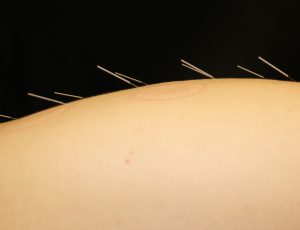
Acupuncture
Acupuncture is a complete medical system that is used to diagnose and treat illness, prevent disease and improve well-being. It is effective for physical, psychological and emotional problems. Acupuncture originated in China more than 3,000 years ago and due to it’s proven effectiveness, has been embraced throughout the world. The intent of acupuncture therapy is to promote health and alleviate pain and suffering. The method by which this is accomplished, though it may seem strange and mysterious to many, has been time tested over thousands of years and continues to be validated today.
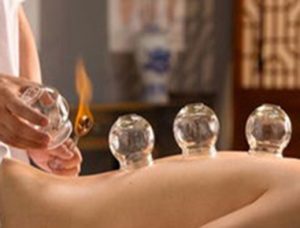
Cupping
Cupping therapy is an ancient form of alternative medicine in which a local suction is created on the skin. Suction is created using heat (fire) or mechanical devices (hand or electrical pumps). According to traditional Chinese medicine (TCM) cupping could dispel stagnation — stagnant blood and lymph, thereby improving qi flow — to treat respiratory diseases such as the common cold, pneumonia and bronchitis. Cupping also is used on back, neck, shoulder and other musculoskeletal conditions. Its advocates say it has other applications, as well.
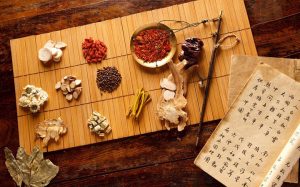
Herbal therapy
Chinese Herbal therapy is the main treatment method within Traditional Chinese Medicine (TCM). TCM is the world’s oldest, continually practiced professional medicine. Its written history stretches back over 2,500 years and its practice is probably much older than that. Although acupuncture was the first Chinese method of treatment to gain wide acceptance in the West, Chinese herbal medicine is quickly establishing itself as one of the most popular and effective alternative therapies in the West.
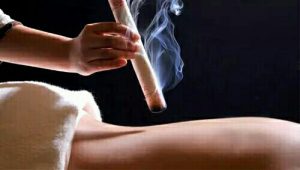
Moxibustion
Moxibustion is a Traditional Chinese medicine(TCM) therapy using moxa made from dried mugwort(Artemisia argyi). Practitioners use moxa to warm regions and meridian points[6] with the intention of stimulating circulation through the points and inducing a smoother flow of blood and Qi. It can treat conditions associated with the “cold” or “yang deficiencies” in Chinese Medicine. It is claimed that moxibustion mitigates against cold and dampness in the body, and can serve to turn breech babies.Moxibustion could be especially effective in the treatment of chronic problems, “deficient conditions” (weakness).
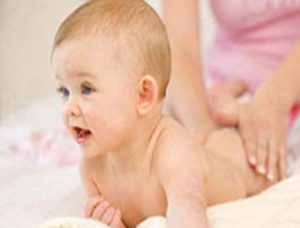
Pediatric Tuina
Many parents remain hesitant to bring kids in for acupuncture because babies, toddlers, kids and even the parents themselves may be frightened of needles.However,there are several other methods of treatment beyond needling that are comfortable for the child.
Tui Na is a Gentle Alternative to Acupuncture
Tui Na is an especially attractive option for treating children because it is so gentle and induces no unwanted side effects. Pressure points are activated without the use of needles, so the overall flow of energy can be manipulated, just as with the practice of acupuncture. A practitioner of Tui Na can identify blockages in the meridians, imbalances of Chi and blood, and use soothing massage to restore the body to a healthy and strong state.
In Chinese medicine, massage is called Tui Na (twee-naa). For infants and small children under 6, this is always the first line of treatment .children respond well to this gentle form of therapy.One of the best things about the health of children is their ability to heal quickly. They generally have rapid shifting of symptoms, however intense they may seem at the moment.
In Chinese medicine, we say that infants, babies and toddlers are yang in nature, meaning that they grow and learn fast, get sick quickly, with fast resolution of their illness, and tend to have more hot, feverish illnesses. When children are sick, there is disorder in their Qi (chee), and it is part of the goal of my treatments to restore order to the qi using gentle and tolerable treatments. The Qi is superficial, and is easily accessed on the skin, which is why massage is one of the best tools to use for children.
Tui Na is a sophisticated technique that can be used to treat not only aches and pains, but also medical conditions like insomnia, hypertension, ulcers, and arthritis. Tui Na looks beyond muscular tension to stimulate the natural healing capability of our bodies. By applying pressure to specific points along the skin, the massage therapist can promote the release of neurotransmitters that help to strengthen the immune system.
Application of Pediatric Tui Na
Pediatric Tuina applies these same massage techniques to the development of a healthy sensation of touch in young children. Research has shown that babies and infants thrive from the touch of a loving parent. In fact, children who receive this sort of attention are healthier and gain weight properly throughout their development.
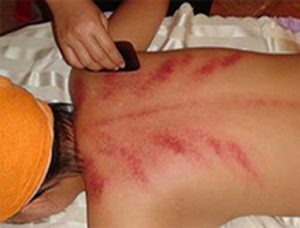
Guasha Therapy
Gua sha (called “spooning” or “coining” ), meaning “scraping sha-bruises”, is a Traditional Chinese medical(TCM) treatment in which the skin is scraped to produce light bruising. It involves repeated pressured strokes over lubricated skin with a smooth edged instrument. The smooth edge is placed against the oiled skin surface, pressed down firmly, and then moved down along the pathway of the acupuncture meridians.Gua sha releases unhealthy elements from injured areas and stimulates blood flow and healing.